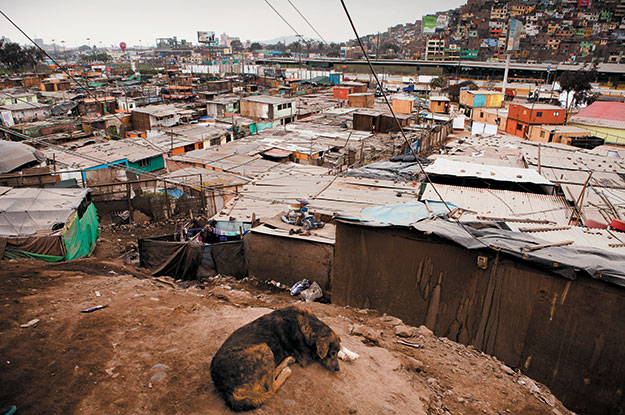The pueblo joven, or shantytown, of Cantagallo sits atop a former landfill in Lima, wedged between a freeway and the Rímac River. Founded in 2000 by roughly 15 indigenous Shipibo families who were part of a mass exodus of Amazonian immigrants pushed out of their communities by logging, illegal mining and infrastructure development in the Amazon Basin, Cantagallo grew into an important center of indigenous identity and culture in Peru’s capital — an example of how an indigenous community could navigate urban life without losing its roots.
But the residents of Cantagallo are about to be uprooted again.
As part of a massive beautification project of the Rímac River, the city plans to demolish the makeshift shacks and storefronts that have transformed the former landfill into a bustling community in the past 15 years — and turn it into a park.
The approximately 200 Shipibo families now living in Cantagallo have been promised a 77,000-square-foot housing area on Lima’s northern edge. But since the city’s new mayor, Luis Castañeda, was sworn into office earlier this year, plans to relocate them have yet to be honored.
That has left the residents of Cantagallo confused and uncertain about their future. Olga Mori Díaz, a mother of five who was born and raised in the Amazon, wonders what will happen to the Comunidad Shipiba elementary school. Established in 2008 by a group of Shipibo parents, it is the capital’s only bicultural and bilingual elementary school that serves indigenous residents.
“If we can rebuild our school in the new site and have enough space for a market where we can sell our own crafts, I’ll be happy,” she says.
But so far no answers are forthcoming.
Life in Cantagallo has always been precarious. The Rímac is Lima’s most polluted river. Residents’ wooden shacks sit on top of an enormous pile of trash, and government services are sparse.
But while urban life presents many challenges for the Shipibo and the estimated 40 percent of Latin America’s indigenous peoples living in towns and cities, it is not without its benefits. In fact, a 2008 U.N. Development Program report found that indigenous peoples living in urban areas get better access to education and basic sanitation, and have higher child survival rates than those in rural areas.
Peru’s Amazonian migration surged in the 1990s, led mostly by Shipibos, and followed by Asháninka, Awajún, Wampis and other groups. Thanks in part to this rural-to-urban migration, Lima’s population has almost doubled in the past 15 years, with new arrivals settling in informal communities like Cantagallo in and around the city.
Harry Pineda, 26, was brought to Lima when he was 8 years old from a small village along Peru’s Ucayali River by his parents, who were artists. Growing up, he felt part of two worlds: the one his parents left behind and the life of a busy urban center.
“Once we came to Cantagallo, my parents were happy to be part of a Shipibo community,” he says, sitting on a bare mattress inside the one-room shack where he lives and works. “They passed on to me their passion for painting scenes from life in the jungle.”
Today, he’s illustrating a children’s book about the Amazon.
Many of Cantagallo’s residents, like the Pineda family, flourished in their new community, finding a ready market for their craft s and artwork. Others work in service jobs or as teachers or police officers.
“In our community, the women keep doing what we did back in our villages — we sew, embroider, paint and make pottery,” says Mori, pointing to the traditional Shipibo kené designs on her wall. “But our kids get to do much more. They get to study and go on to college.”
The case of Cantagallo challenges many assumptions about the migration of indigenous peoples into Latin America’s cities. Against all odds, they have, thus far, been able to preserve their heritage in the midst of dislocations.
“One thing we should keep in mind about new indigenous migrants to Lima is their shared indigenous pride and identity,” says Ismael Vega Díaz of Lima’s Amazon Center of Anthropology and Practical Application.
The question now is whether they can continue to maintain their culture in the face of Latin America’s rapid urban development. In the case of Cantagallo, Vega is hopeful.
“Peruvian society is changing, and we see more tolerance these days. Migrants from indigenous Amazonian communities have not tried to hide their identity when they come to the city, and this fact is allowing them to demand and access the rights that the state has denied them for so many years.”
—
Ruxandra Guidi is a reporter with 15 years of experience working in public radio, magazines and multimedia. Based in Quito, Ecuador, she collaborates regularly with her husband, Bear Guerra, under the name Fonografi a Collective. Guidi’s and Guerra’s reporting was made possible by a grant from the International Reporting Project.






